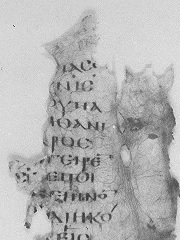Related Research Articles

Uncial 0184, is a Greek-Coptic diglot uncial manuscript of the New Testament, dated paleographically to the 6th century.

Uncial 0186, is a Greek uncial manuscript of the New Testament, dated paleographically to the 5th-century.

Uncial 0208 is a Greek uncial manuscript of the New Testament, dated paleographically to the 6th century.

Uncial 0210, is a Greek uncial manuscript of the New Testament, dated palaeographically to the 7th century.
Uncial 0211, ε 051 (Soden), is a Greek uncial manuscript of the New Testament, dated paleographically to the 7th century.

Uncial 0213 is a Greek uncial manuscript of the New Testament, dated palaeographically to the 5th or 6th century.
Uncial 0214, is a Greek uncial manuscript of the New Testament, dated palaeographically to the 4th or 5th century.
Uncial 0216, is a Greek uncial manuscript of the New Testament, dated palaeographically to the 5th century.

Uncial 0217, is a Greek uncial manuscript of the New Testament, dated palaeographically to the 5th century.
Uncial 0218, is a Greek uncial manuscript of the New Testament, dated palaeographically to the 5th century.
Uncial 0219, is a Greek uncial manuscript of the New Testament, dated paleographically to the 4th century. The codex contains a small parts of the Epistle to the Romans, on 2 parchment leaves. It is written in two columns per page, 26 lines per page.

Uncial 0221, is a Greek uncial manuscript of the New Testament, dated palaeographically to the 4th century. The codex contains a small part of the Epistle to the Romans (5:16-17,19,21-6:3) on 2 parchment leaves. The text is written in two columns per page, 20 lines per page.
Uncial 0222, is a Greek uncial manuscript of the New Testament. The manuscript paleographically had been assigned to the 6th century. It contains a small parts of the First Epistle to the Corinthians (9:5-7,10,12-13), on 1 parchment leaf. It is written in two columns per page, 20 lines per page.
Uncial 0223, is a Greek uncial manuscript of the New Testament. The manuscript paleographically had been assigned to the 6th century. It contains a small parts of the Second Epistle to the Corinthians (1:17-2:2), on 1 parchment leaf. It is written in two columns per page, 17 lines per page.
Uncial 0226, is a Greek uncial manuscript of the New Testament. The manuscript paleographically had been assigned to the 5th century. It contains a small parts of the First Epistle to the Thessalonians (4:16-5:5), on one parchment leaf. It is written in two columns per page, 25 lines per page.

Uncial 0227, is a Greek uncial manuscript of the New Testament. The manuscript paleographically had been assigned to the 5th-century. It contains a small parts of the Epistle to the Hebrews (11:18-19,29), on one parchment leaf. It is written in two columns per page, 23 lines per page.

Uncial 0228, is a Greek uncial manuscript of the New Testament. The manuscript paleographically had been assigned to the 4th century. It contains a small parts of the Epistle to the Hebrews (12:19-21,23-25), on 1 parchment leaf. Written in one column per page, 17 lines per page.
Uncial 0234, ε 49, is a Greek uncial manuscript of the New Testament. Paleographically it has been assigned to the 8th century.
Uncial 0237, ε 014, is a Greek-Coptic uncial manuscript of the New Testament. Paleographically it has been assigned to the 6th-century.
Uncial 0242, is a Greek uncial manuscript of the New Testament. Paleographically it has been assigned to the 4th century.
References
- 1 2 3 4 Aland, Kurt; Aland, Barbara (1995). The Text of the New Testament: An Introduction to the Critical Editions and to the Theory and Practice of Modern Textual Criticism. Erroll F. Rhodes (trans.). Grand Rapids: William B. Eerdmans Publishing Company. p. 125. ISBN 978-0-8028-4098-1.
- ↑ "Liste Handschriften". Münster: Institute for New Testament Textual Research. Retrieved 18 December 2015.
- ↑ Kurt Aland (1963). Kurzgefasste Liste der griechieschen Handschriften des Neuen Testaments. Berlin: Walter de Gruyter. p. 10.